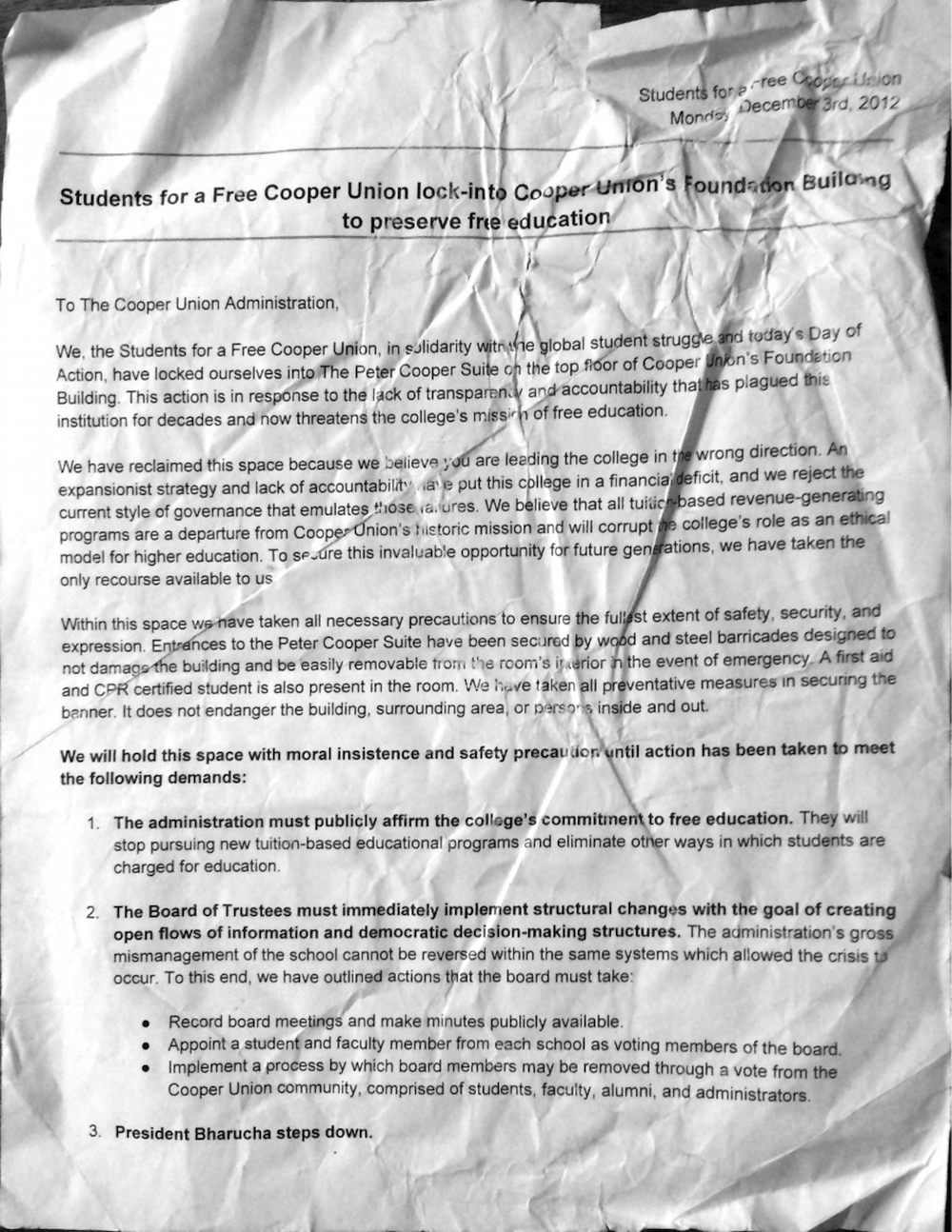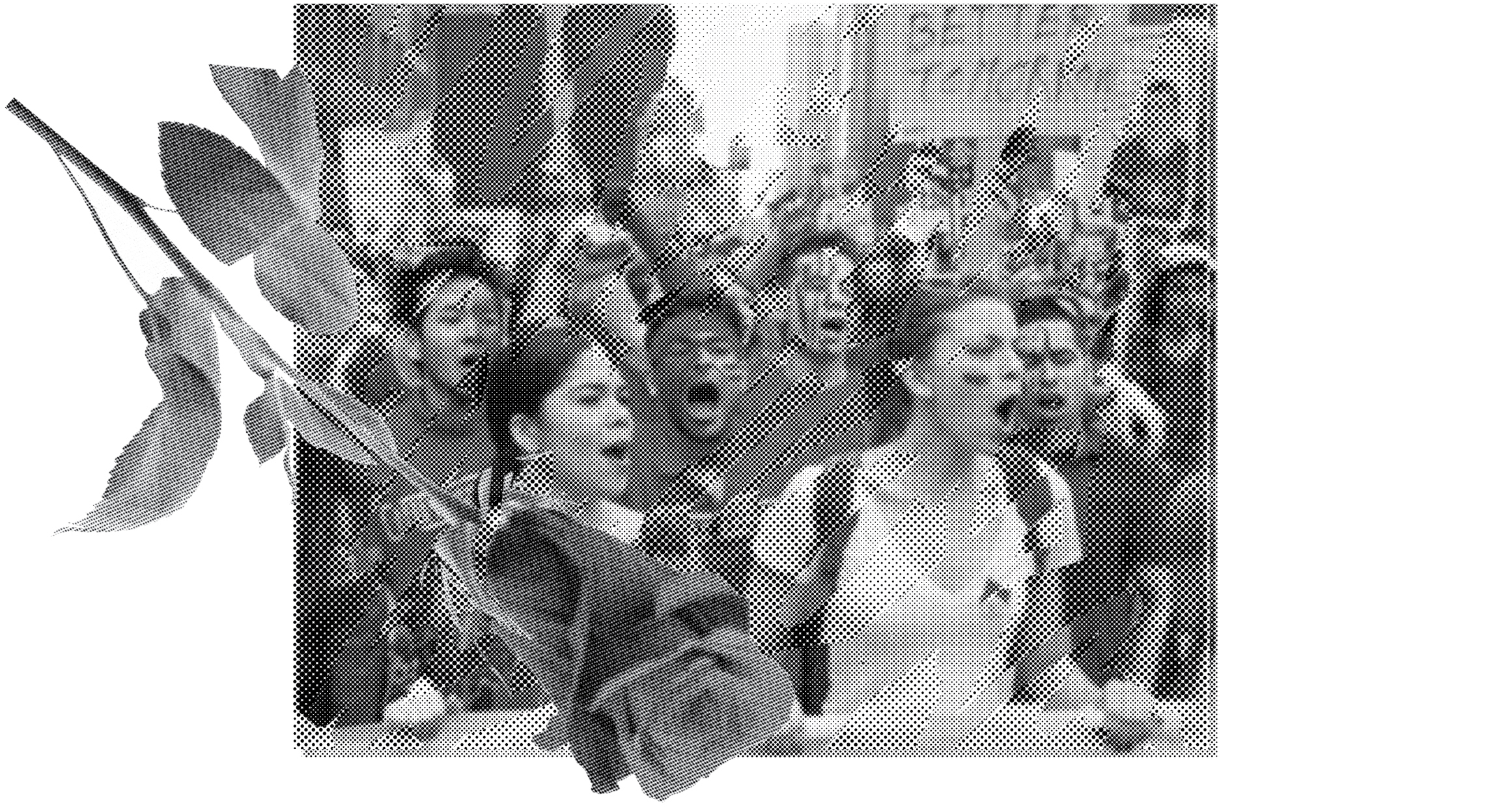

Free Cooper Union, founded in Fall 2012, is a group of students and alumni working towards free education to all.
We affirm:
- Tuition is a betrayal of Cooper Union’s radical mission, in addition to the fact that it isn’t a sustainable financial model.
- Higher education around the world is in dire need of a paradigm shift.
- The debate about “tuition” at Cooper must engage broader dialogues about student debt, educational reform, alternative models of governance, and social justice.
- This is not a financial scandal, it’s a cultural crisis.
To this end, we have employed a wide range of tactics including but not limited to: drafting petitions, holding walk outs, hosting summits, igniting memes, building satirical websites, mounting art exhibitions, creating music videos, leading parades, staging historical reenactments, authoring publications, posterbombing, culture-jamming, breaking into meetings, leaking documents, dropping banners, talking to press, building barricades, occupying, and envisioning futures and possibilities.
In December 2012, eleven students and an embedded reporter barricaded themselves inside the clocktower of the Foundation Building, dropped a gigantic banner reading “Free Education to All,” and issued the following statement:

A set of principles was also issued, expanding upon larger systems:
Principles
Higher Education Bubble
The over-inflated costs of higher education have placed more than a trillion dollars of debt onto the backs of students. Higher education should be a means of social mobility and intellectual liberation, but it has devolved into an industry that exploits students for profit. Inevitably this bubble will burst and what appears to be a healthy and growing educational system will be revealed as a model that was always doomed to fail.
Grow Down
The administrators who have grown us into this mess are trying to grow us out of it. Investing in the higher education bubble is short-sighted and uncreative. Playing a larger role in one’s community provides strong roots. If we refuse to invest in a growth model and reaffirm our mission, we stand to see the principles of free education bring life back to our own community and other institutions as well.
Structures for Transparency and Integrity
Bloated and visionless administrations have become an epidemic threatening institutions of higher education all across America. We must rebuild the governance of these institutions with open flows of information and democratic decision-making structures. Carrying a mission such as free education will require principled, rather than self-sustaining, leadership.
Direct Action
Isn’t the world so messed up? There are different ways to go about changing things: exposing an existing problem, highlighting an alternative, or demonstrating a possible solution, are some examples. Imagine two categories of action: indirect and direct.
| Indirect Action | Direct Action |
|---|---|
| Asking somebody to make the change you wish to see | Acting to create the change you wish to see |
|
Sharing an important news article with friends Signing a petition for a cause you support Voting for a representative Writing a letter to your elected official |
Teaching a “Know Your Rights” workshop to high-schoolers Planting a garden to remediate local soil Blockading a road to prevent work on a gas pipeline |
We’re raised to view indirect action as the most respectable way to create change but it’s not. Direct action breaks through delicate sensibilities with a massive and highly effective breadth of tactics.

The Futility of Bureaucracy
Bureaucratic institutions, such as Cooper, are so internally complex and inefficient that they defy change from within. This is why working primarily within the structures of an institution is less effective than the tamest actions taken outside of them. If you look deeply into almost any type of institution, you will find hidden histories of direct action being used by communities to turn perceived inevitabilities into self-determination.
Following the announcement of Cooper’s “financial crisis” in October 2011, the community spent an entire year attempting to work with the administration. It soon became apparent that the administration had no real intention of listening to community concerns. The community had no real agency: Bharucha’s approach turned out to be a way of manufacturing community buy-in for tuition and Q&A forums with Trustees created a false dialogue which left tough questions unanswered.
The community moved towards indirect action. However, petitions and walk-outs failed to garner attention beyond local blogs, and community summits produced brilliant talk but few results.
The decision to take direct action against the administration was complicated by the fact that up until April 2013 the entire administration repeated again-and-again that, “tuition will be implemented only as a last resort.”
The plausible deniability of tuition created an air amongst the student body that things might work out for the better if everyone attended enough Q&A sessions and emailed the administration with creative money-making schemes.
Three years later, documents were leaked revealing that the administration’s messages about “sustainability” and inclusion had been crafted by consultants to minimize conflict, and plans for tuition had been in the works since before Bharucha was hired by the Board to “Reinvent” Cooper.
Direct Action Gets the Goods
In November 2012, to accuse the administration of intending to charge tuition was to be pigeonholed as a conspiracy theorist, a reactionary, a pessimist, and an uninformed kid. Nonetheless, students began quietly organizing action planning meetings. 14 secret late-night meetings were held between a rotating crew of about 50 students. Discussion ranged from the big picture of educational and financial systems, to logistics about “food, water, and shit” in an action scenario. These meetings resulted in the founding of Free Cooper Union, and the first major direct action known as the Lock-In.
The Lock-In (December 3rd - December 10th, 2012) was an action in which eleven students barricaded themselves into the Foundation Building’s clocktower to draw attention to an upcoming Board about tuition. This catalyzed the community, leading to a barrage of actions in a single jam-packed week: an early set of tuition models leaked to the public, students on the ground broke into the Board meeting and livestreamed as they disrupted a discussion about implementing tuition, a city-wide rally on education erupted outside the Foundation Building, and Cooper’s struggle received national and then global mainstream media attention.
On April 23, 2013, the Board finally announced that they intended to charge tuition, implementing a “half- scholarship” model starting with the incoming class of 2018. The announcement underscored to the entire community how severely out of touch and deceitful the Board is. After The New York Times reported that the announcement of tuition marked the “End of an Era,” students sought to prove that Cooper’s future isn’t up to The Times or even the Board to decide. In May 2013, a group of over one hundred students took the office of President Bharucha to deliver a Vote of No Confidence. Bharucha refused to meet with the students to discuss their concerns — having caught wind of the action, he fled campus.
In the space of the action, The Times changed their tune, reporting that students had incited, “a running debate about how to alter history.” The Occupation lasted for 65 days (May 8th - July 12th, 2013) placing it among the longest student occupations in US history.
Le Rêve Infini
During 2012’s monumental student strikes in Quebec, a play on words emerged in which the “general strike” (grève infini) was crossed with the idea of an infinite dream (rêve infini). The space of an action is not unlike an infinite dream: realities based on limitation are transformed — in an instant — into a boundlessness of time, space, and possibility. The action itself ends, but everyone in its path remains changed, retaining a boundlessness within themselves.
